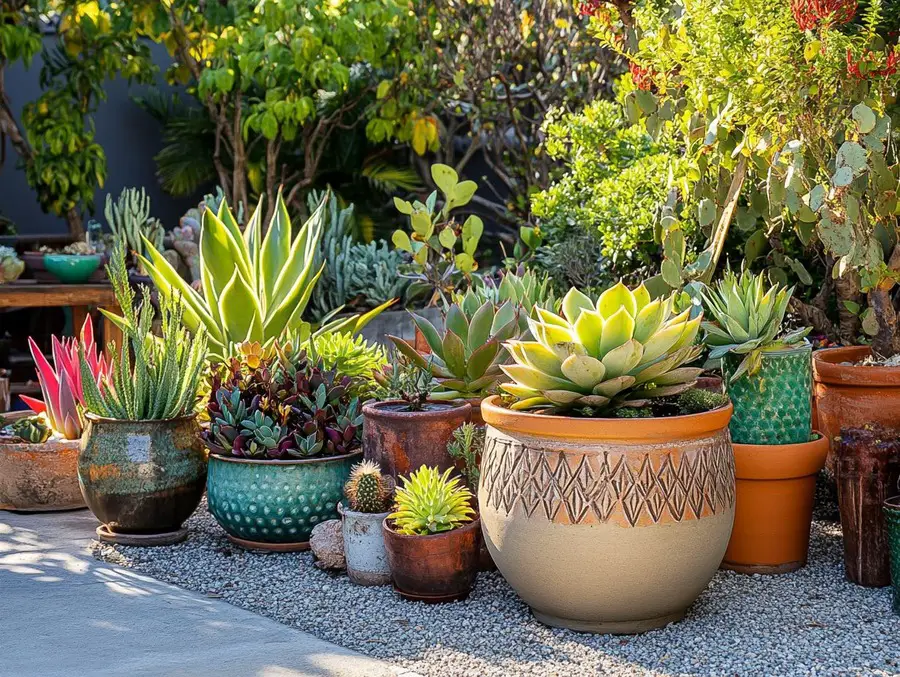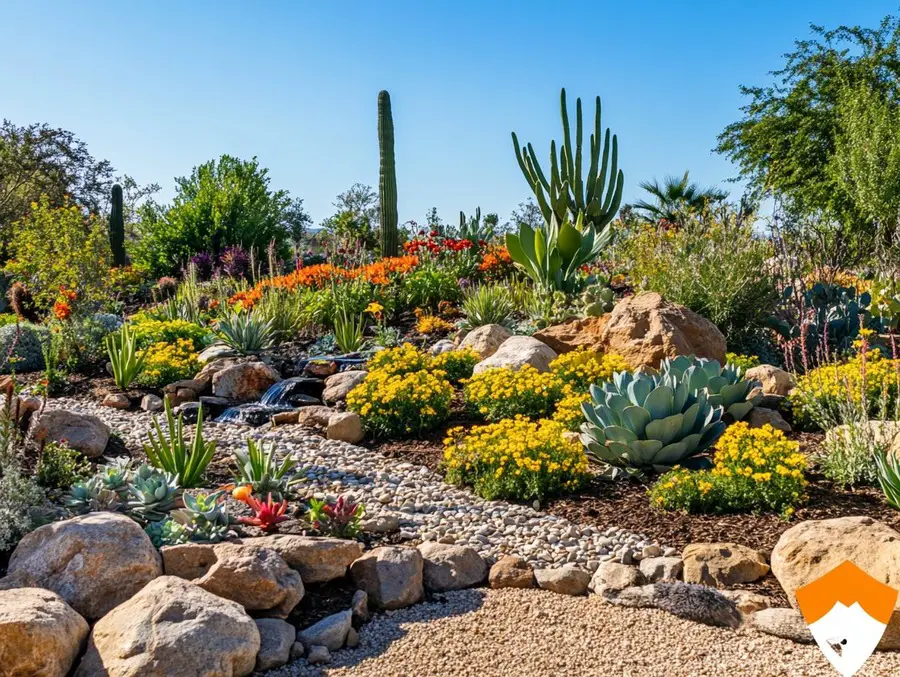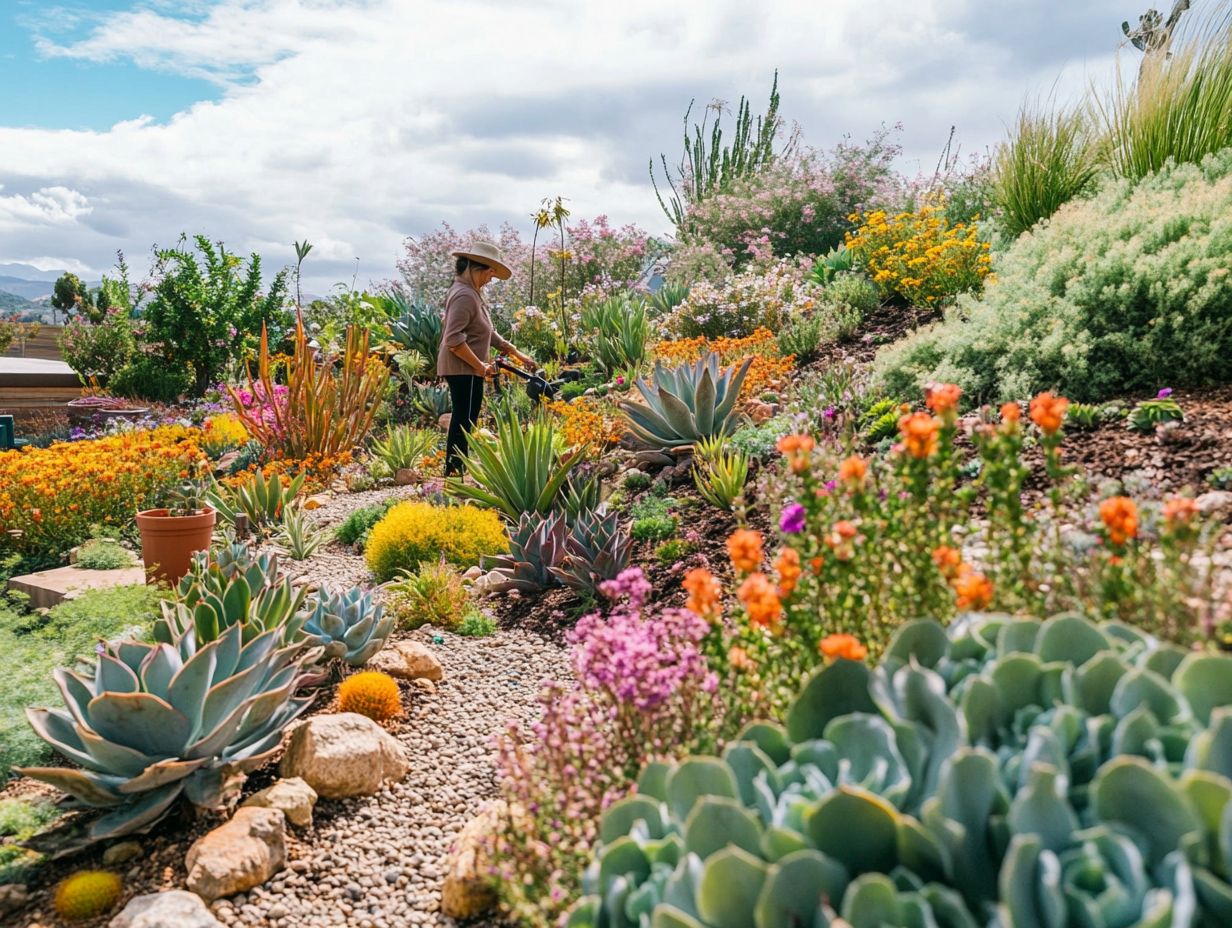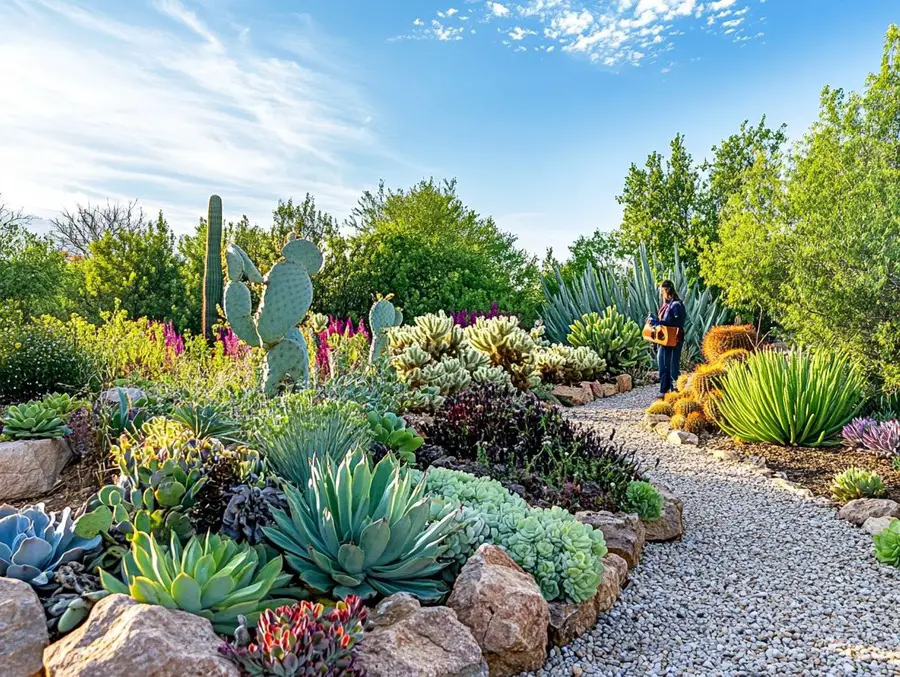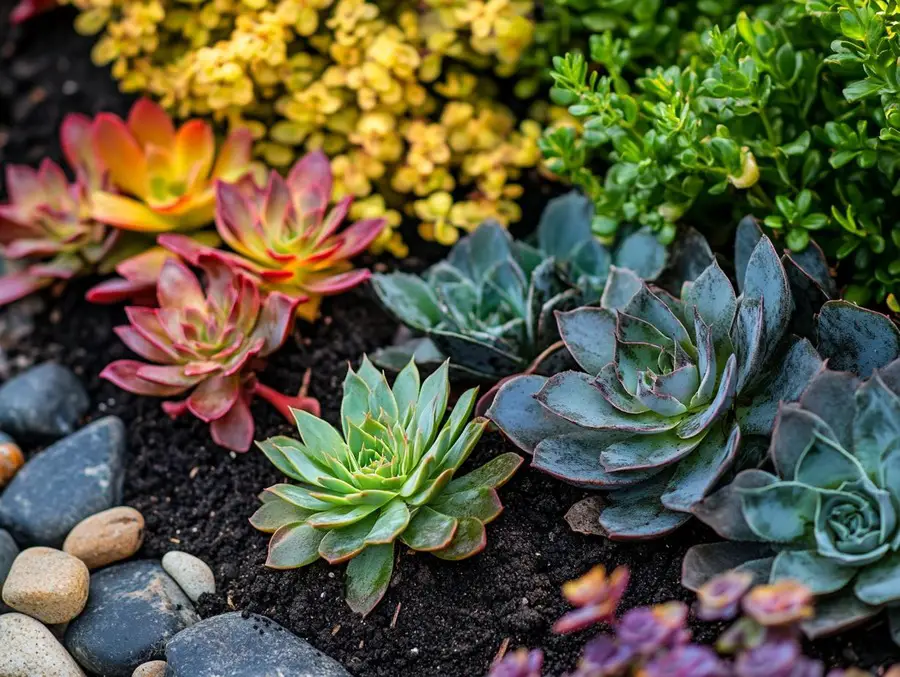We use affiliate links. If you purchase something using one of these links, we may receive compensation or commission.
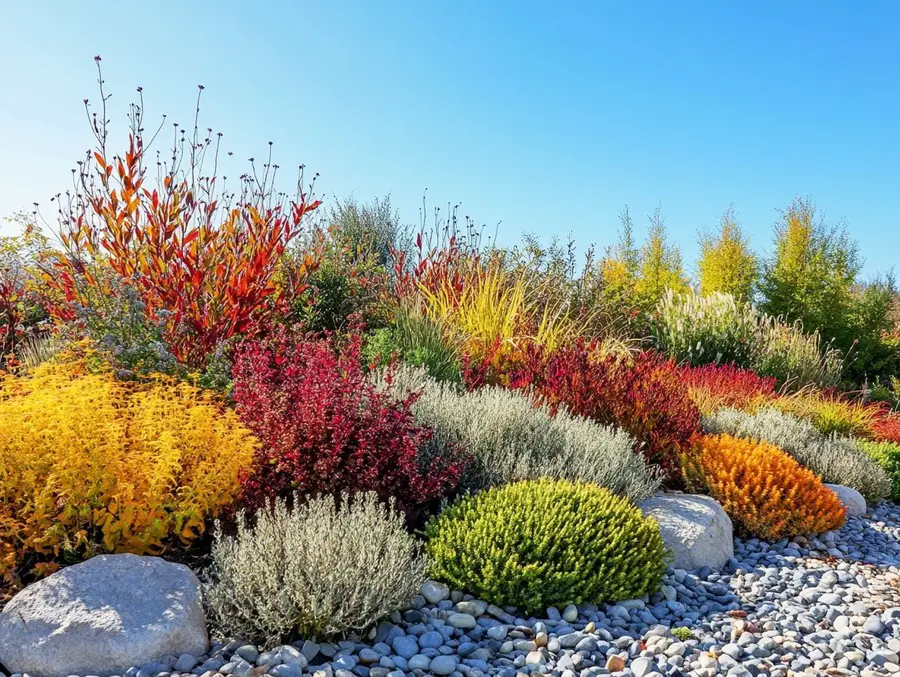
Shrubs for Xeriscaping are the perfect way to add lasting beauty to your garden while cutting back on water use.
Struggling to keep plants alive in dry conditions?
The right drought-tolerant shrubs thrive with minimal effort, providing year-round greenery and structure.
With smart plant choices and simple care, you can create a lush, low-maintenance landscape that conserves water and looks amazing!
Shrubs for Xeriscaping
Key Takeaways
- Shrubs for Xeriscaping are drought-tolerant plants that thrive in low-water landscapes.
- Popular choices include lavender, sagebrush, and yucca, which require minimal care.
- These shrubs help retain soil moisture, reduce erosion, and provide year-round greenery, making them an excellent choice for sustainable, water-wise gardening.
Shrubs for Xeriscaping: Thriving Gardens with Minimal Irrigation
Xeriscaping is a clever landscaping technique that helps you save water while creating beautiful outdoor spaces.
One of the best ways to achieve this is by adding shrubs to your xeriscape garden.
When you incorporate shrubs, you’ll enjoy a bunch of benefits, like reduced water usage and lower maintenance needs.
You’ll want to learn how to pick the right varieties, whether they’re native plants or drought-tolerant options.
I’ll share essential tips on planting and taking care of them.
You’ll discover how to seamlessly integrate shrubs into your landscape design, creating a stunning and sustainable garden.
It’s time to transform your outdoor space while conserving those precious resources!
What is Xeriscaping?
Xeriscaping is a game-changer when it comes to landscaping, allowing you to create stunning outdoor spaces while saving water.
This approach is particularly useful in arid regions where drought-resistant plants really shine.
It’s all about using native plants and low-water shrubs to craft a sustainable garden that looks great and helps the environment.
By considering factors like climate, soil types, and smart plant choices, you can enjoy a vibrant garden that requires minimal maintenance and water, reducing your environmental footprint.
With water scarcity becoming a pressing issue, embracing xeriscaping techniques is more important than ever.
By choosing plants that thrive in your local climate, you can cut down on irrigation needs and play your part in water conservation.
This method also boosts soil health by reducing erosion and enhancing biodiversity, as native plants attract beneficial wildlife.
Through practical garden education, you’ll learn how to care for xerophytes—plants that thrive in dry conditions, giving you a better grasp of sustainable practices.
In the end, adopting xeriscaping saves you money and deepens your appreciation for the natural landscape and the need to preserve it.
Benefits of Using Shrubs for Xeriscaping
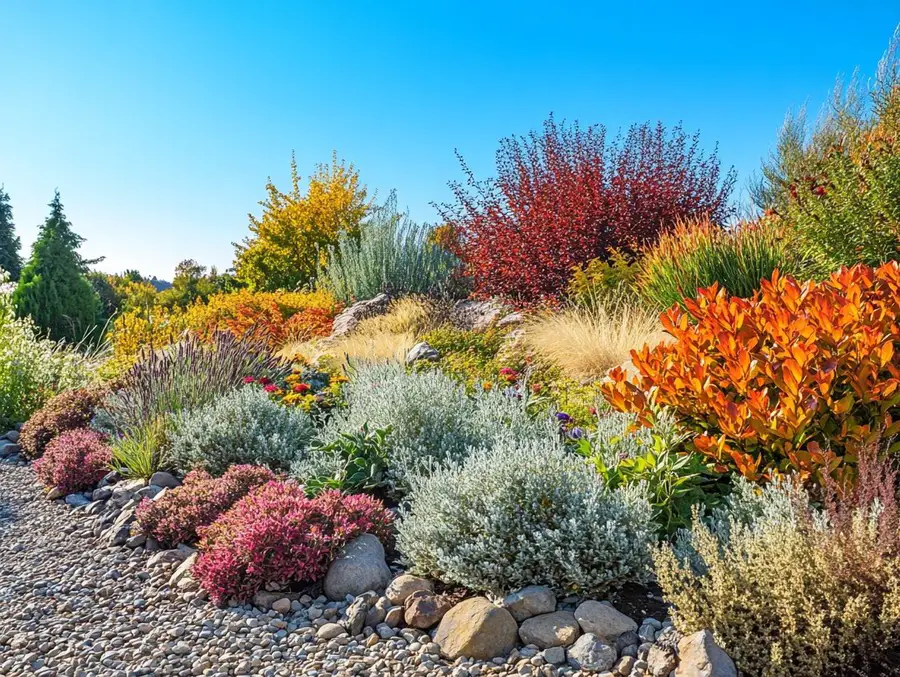 Using shrubs for xeriscaping can bring you a bunch of benefits.
Using shrubs for xeriscaping can bring you a bunch of benefits.
They look great, and they help with water conservation and make your garden more sustainable.
If you opt for low-water varieties and native species, you’re on your way to creating a landscape that can handle those dry conditions while cutting down on the need for irrigation.
Shrubs are fantastic for keeping soil moisture in check, controlling erosion, and providing a cozy habitat for local wildlife.
They really are a smart choice for anyone interested in eco-friendly gardening.
Reduced Water Usage
One of the biggest perks of adding shrubs to your xeriscape garden is how they help cut down on water usage.
This makes them a crucial part of any effective water conservation strategy.
By using drought-resistant plants and optimizing your irrigation methods, these low-water shrubs can really boost soil moisture retention and promote sustainable gardening practices.
These incredible plants can sharply reduce your irrigation needs, especially when you pair them with smart moisture management techniques like drip irrigation and mulching.
This combo delivers water right to the roots and helps minimize evaporation.
Shrubs like lavender and yarrow are champions when it comes to thriving in various soil types and climates.
They show impressive resilience while naturally improving soil health.
Their deep root systems enhance soil structure and help with effective moisture management, providing crucial support to the plants around them.
By creating an ecosystem where shrubs and beneficial soil organisms can thrive, you can further cut down on water requirements and cultivate a robust environment that flourishes even in dry conditions.
Low Maintenance
One of the most appealing things about using shrubs for xeriscaping is how little maintenance they need to stay healthy and thriving—perfect for you busy gardeners out there.
Many native plants and drought-tolerant shrubs come with built-in pest resistance and require minimal pruning, which means you can kick back and enjoy a flourishing garden with less effort.
This gives you more time to relax in your outdoor spaces instead of constantly worrying about upkeep.
Take shrubs like sagebrush and desert marigold, for example; they thrive in hardiness zones 8 through 10 and show off some impressive resilience and adaptability.
You’ll find that seasonal care for these plants is pretty straightforward, usually just needing a drink during those extreme drought periods.
And don’t forget about incorporating companion plants!
They can help improve soil structure and keep pests at bay, contributing to a healthy ecosystem.
By adopting these sustainable gardening practices, you boost biodiversity and also create habitats that attract those beneficial insects, making for a vibrant and self-sustaining garden environment.
Choosing the Right Shrubs for Xeriscaping
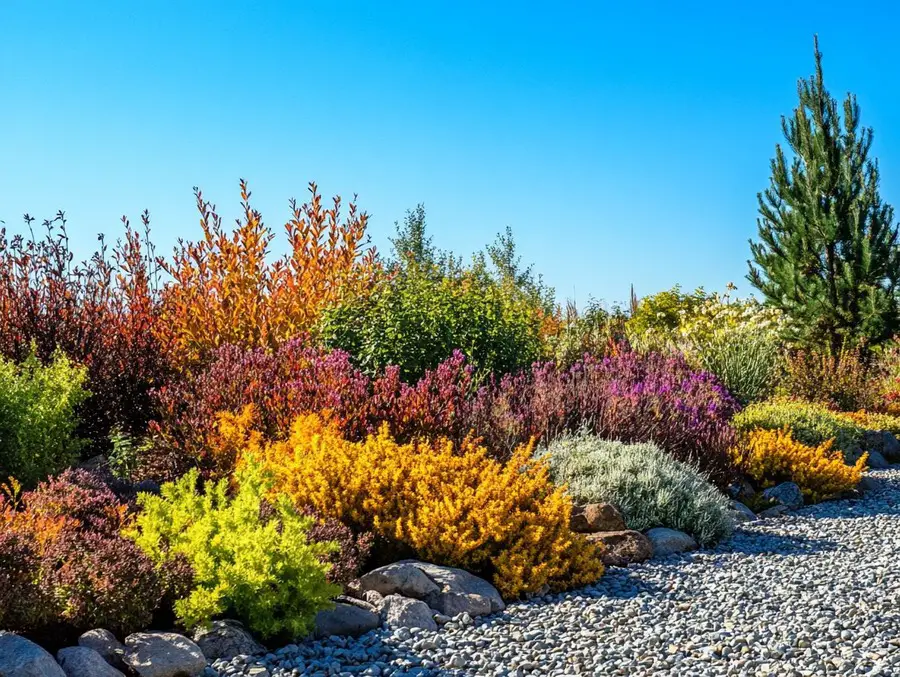
Choosing the right shrubs for your xeriscape garden is crucial if you want to keep your plants healthy and make the most of your water-efficient landscaping.
When you’re picking out plants, think about the pros and cons of native versus non-native species.
Native plants usually adapt better to your local soil and climate, which means they’re more drought-tolerant and don’t depend as much on irrigation.
By getting to know the characteristics of different shrubs and how well they can thrive in your specific environment, you can create a beautiful, sustainable garden that’s easy to maintain.
Native vs. Non-native Species
When you’re picking shrubs for xeriscaping, it’s important to know the difference between native and non-native species, as each type offers different ecological perks for your garden.
Native species are like the locals; they’re adapted to your area’s conditions and provide essential support for local wildlife and pollinators.
Non-native species might catch your eye with their unique looks, but they can sometimes fall short in pest resistance and sustainability.
Choosing native shrubs like sagebrush or lavender usually means less maintenance and better drought tolerance, making them perfect for dry climates.
These plants thrive in local conditions and help support biodiversity by attracting birds, bees, and other helpful insects.
On the flip side, non-native options like barberry or certain ornamental shrubs may need more watering and chemical treatments, which can throw off the local ecosystem.
While they can certainly make your space look good, their role in creating habitat isn’t as strong as that of native plants.
Ultimately, weighing these factors will help you create a more sustainable and resilient garden landscape.
Drought Tolerant Options
Selecting drought-tolerant options is key for creating a xeriscape garden that can thrive in low-water conditions, letting you enjoy a vibrant landscape with minimal irrigation.
You’ll find that many perennial shrubs and low-water varieties are excellent choices since they have adapted root systems that maximize soil moisture retention, making them perfect for sun-loving plants in arid regions.
By choosing the right species, you can establish a visually appealing environment that doesn’t demand much maintenance.
Ideal candidates include varieties like lavender, which loves well-draining soil and full sun, and salvia, which does well in both poor and sandy soils.
Opting for native plants is a smart move since they tend to be pretty resilient against drought while keeping your garden eco-friendly.
These shrubs bring seasonal interest with their lush foliage and beautiful blooms, boosting the aesthetic appeal while supporting sustainable practices.
Incorporating these plants conserves water and promotes local biodiversity, making a lasting impact on environmental health.
Planting and Maintaining Shrubs for Xeriscaping
Successfully planting and maintaining shrubs for xeriscaping means you need to use the right techniques and understand the unique needs of drought-resistant plants to keep them healthy and thriving.
By getting the hang of plant selection, soil amendments, and proper watering methods, you can create a beautiful garden that looks great, saves water, and provides a habitat for wildlife.
Proper Planting Techniques
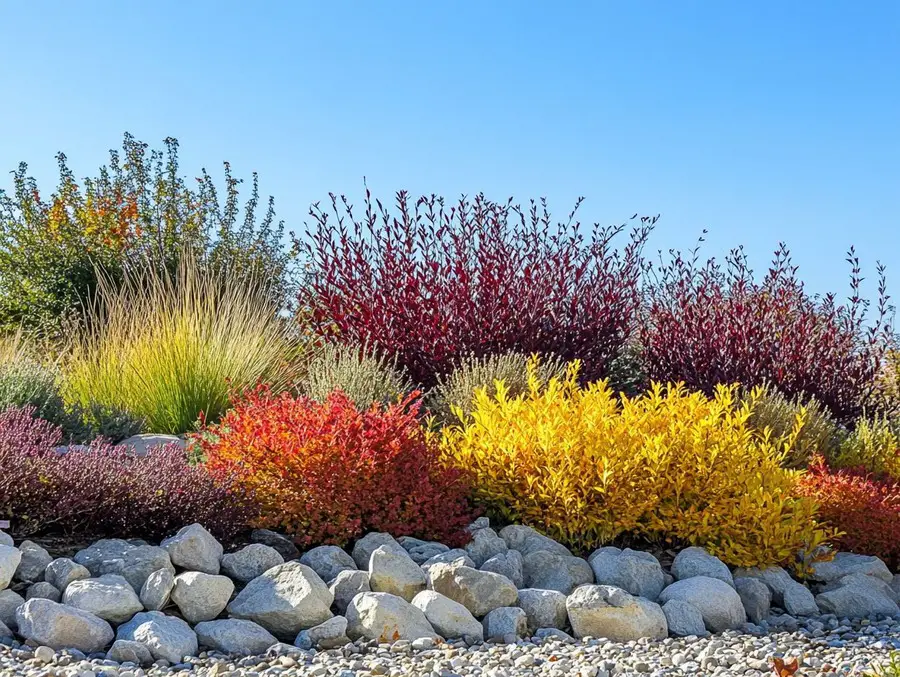
Implementing proper planting techniques is key to making your xeriscape garden a success.
It sets the stage for healthy root systems and healthy soil.
By getting to know your soil type and making sure it retains enough moisture, you can give your chosen shrubs the best chance at thriving in a sustainable landscape.
- First things first—you’ll want to prepare those planting holes properly. They should be wide and deep enough to let the roots spread out without feeling cramped. This helps the plants dig deep for nutrients and water.
- Don’t forget about spacing! Keeping enough distance between your shrubs is important to avoid competition for resources and to promote good airflow.
- Adding organic matter like compost to your soil can work wonders, boosting soil health and improving drainage and nutrient availability.
To check if your soil is up to par, take a look at its texture and pH.
This way, you can ensure your plants thrive through the seasons with seasonal care like mulching and regular moisture checks.
Watering and Pruning Tips
Effective watering and pruning techniques are key to keeping your xeriscape shrubs healthy and vibrant, making sure they stay drought-tolerant.
By tailoring your watering schedule to what your plants specifically need and knowing when and how to prune, you can really boost their resilience and longevity.
For the best results, think about deep watering early in the morning or late in the evening.
This way, your plants get better absorption and you minimize evaporation.
During those scorching hot months, you might need to tweak your watering frequency.
Keeping a close eye on soil moisture levels will help prevent stress on your plants.
Regarding pruning, aim to chop off any dead or damaged branches at the start of the growing season.
This encourages new growth and helps your shrubs keep their shape.
Keeping an eye on local weather conditions will help you adjust your watering practices.
It’s all about being smart with your techniques, especially during droughts, so you can conserve water while still giving your plants the care they need.
Designing a Xeriscape Garden with Shrubs
Designing your xeriscape garden with shrubs is a fantastic chance for you to create a beautiful outdoor space while also being kind to the environment and conserving water.
By carefully selecting a mix of low-water shrubs and ornamental plants, you can create unique landscape features that look great and also attract local wildlife and add visual interest to your garden.
Incorporating Shrubs into the Landscape
Incorporating shrubs into your landscape can really turn ordinary spaces into vibrant garden beds bursting with texture and color.
They can serve as both eye-catching focal points and practical elements.
By strategically placing shrubs as ground cover or along borders, you can create a layered look that boosts biodiversity and supports local ecosystems.
This approach makes your outdoor spaces more beautiful and also provides habitats for beneficial wildlife, like birds, butterflies, and pollinators.
For example, using native shrubs in your borders can create a natural barrier while offering food and shelter to various species.
And don’t forget about companion planting! Choosing the right shrubs can improve plant health and growth.
By pairing shrubs with complementary flowers or herbaceous plants, you’ll create a dynamic and visually appealing landscape that thrives together and attracts those essential insects, enriching the overall ecological balance in your area.
Frequently Asked Questions
What are xeriscaping shrubs?
Xeriscaping shrubs are plants that are specifically chosen for their ability to thrive in dry, arid conditions.
These shrubs are ideal for xeriscaping, a landscaping method that focuses on conserving water and reducing maintenance.
What are the benefits of using shrubs for xeriscaping?
Shrubs for xeriscaping can significantly reduce the amount of water needed for maintaining a landscape, as they are drought-resistant and require minimal watering.
They also add visual interest and texture to a xeriscaped garden.
Which types of shrubs are best for xeriscaping?
There are many different types of shrubs that are suitable for xeriscaping, but some popular options include lavender, yucca, sage, and juniper.
These plants are all low-maintenance and have adaptations that allow them to survive in dry climates.
How should I care for my shrubs in a xeriscaped garden?
Proper care for xeriscaping shrubs involves regular pruning to maintain their shape and remove dead or damaged branches.
It’s also important to use mulch around the base of the shrubs to help retain moisture and control weeds.
Are xeriscaping shrubs suitable for all climates?
While xeriscaping shrubs are ideal for dry, arid climates, they can also be used in more temperate regions.
However, it’s important to choose shrubs that are suitable for your specific climate and to properly prepare the soil to ensure their success.
Can I use other plants besides shrubs for xeriscaping?
Yes, there are many different types of plants that are suitable for xeriscaping, including succulents, ornamental grasses, and wildflowers.
It’s important to choose plants that are adapted to dry conditions and to plan out a diverse and visually appealing landscape.
Best Plants for Xeriscape Gardens: Hardy & Beautiful
Xeriscape Garden Styles: Easy Low-Maintenance Options
Xeriscape Gardening Techniques: Easy Low-Water Tips
Xeriscape Garden Design & Layout: Easy Water-Wise Beauty
What is xeriscaping? A beginner’s guide to drought-tolerant landscaping – Colorado State University
Related Content
Visit my Amazon Influencer Page for videos and gardening products Grow Your Own Garden

